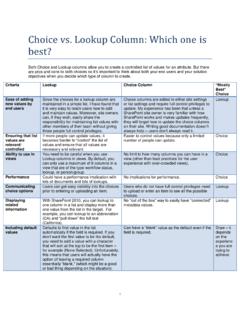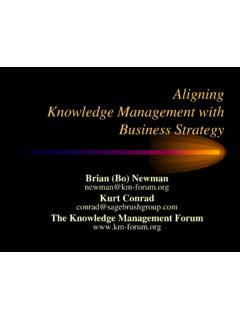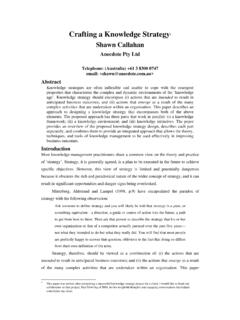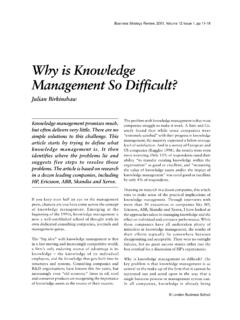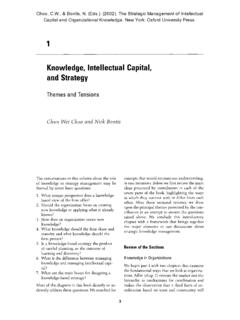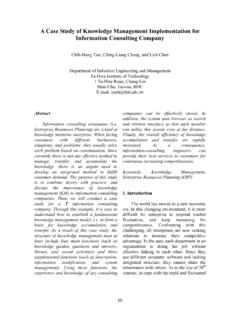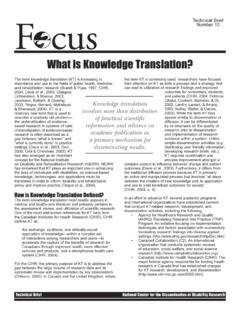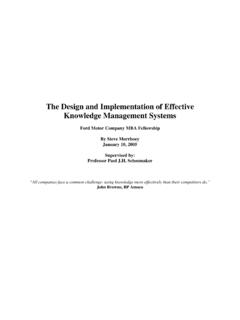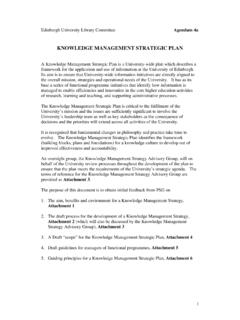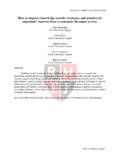Transcription of Metrics Guide for Knowledge Management Initiatives
1 Metrics GuideforKnowledgeManagementInitiativesDE PARTMENT OF THENAVYCHIEFINFORMATIONOFFICERA ugust 2001 Department of the NavyAugust 20011 TABLE OF CONTENTS1. 52. 7 Building a Knowledge -Centric Organization: The Role of 8 What is the Metrics Guide ?.. 93. DESIGNING ACTIONABLE KM PERFORMANCE KM Measurement 12 Who are the Stakeholders and What do They Need to Know?.. 13 Which Framework is Best?..14 What Should be Measured?.. 19 Qualitative and Quantitative 20A Key Qualitative Measurement Strategy: 22 Future 23 KCO Specific 24 How Should We Collect and Analyze the Measures?.. 25 What do the Measures Tell Us and How Should We Change?.. 264. GETTING PROGRAM AND PROCESS 29 Performance 30 Outcome 31 System 32 Case 33 SPAWAR Systems Center Charleston (SSC-CHS).
2 33 Pacific Fleet Solution Provider 356. PROGRAM EXECUTIONAND 43 Performance 44 Outcome 45 System 46 Case 47 Naval Surface Warfare Center (NSWC) Sailor to Engineer 47 General Services Administration Public Buildings Service .. 50 Department of the NavyAugust 200127. PERSONNEL AND 53 Performance 54 Outcome 55 System 55 Case 56 Virtual Naval Hospital ..59 APPENDIX A: SUMMARY OF KM PERFORMANCE B: FURTHER 70 APPENDIX C: DEFINITIONS OF KEY of the NavyAugust 20013 ACKNOWLEDGEMENTSAlex Bennet, Deputy CIO for Enterprise IntegrationDON Team: Sandra Smith (Lead), Jim Carberry, Clay Dean, Ivan Hall, Jack Hawhurst, Brenda Jones, CAPT Jim Kanter, Dr. Moonja Kim, Chuck Mills, CDR Mike Pawley, Lynda Pierce, Dr.
3 JamesPoage (Volpe Center, DOT), Neal Pollock, Ed Schmitz, Rachael Sedeen (graphic artist),Paul Smith, Dawn Walter (graphic artist), Tina White, and Maggie HiserDON Knowledge Management Community of PracticePlural, Inc.: Susan Hanley (primary author)Technology Intelligence International LLC: Dr. Geoffrey Malafsky (primary author) and Steve WalkerGroup Decision Support Systems (GDSS), Inc.: Kathryn BurnsThis Guide presents a practical framework for measuring the value of investments in Knowledge Management Initiatives . This document is designed to be a supplement to theKnowledge Centric Organization (KCO) Toolkit CD produced by DON KCO Toolkit CD lays out the basic Knowledge and activities for helping the DON become a Knowledge Centric Organization.
4 This document seeks to Guide the reader through a process to design and implement performance measures for Guide is also available on the DON CIO web additional information, please contact the Department of Navy Chief Information Officer at of the NavyAugust 20014(This page intentionally left blank.)Department of the NavyAugust 200151. OVERVIEWThe Department of Navy (DON) Chief Information Officer (CIO) has led the development of anInformation Management /Information Technology (IM/IT) Strategic Plan to build a Knowledge sharing culture and exploit new IT tools to facilitate Knowledge transfer across the globally distributed enterprise. To implement this strategy, DON CIO developed the Knowledge Centric Organization (KCO) Toolkit1to assist Navy and Marine Corps organizations in capitalizing on their Knowledge assets and begin imple menting Knowledge Management (KM) within their organizations.
5 Although several definitions of KM exist, DON uses the following definition to highlight the interplay between human and organizational issues: KM is a process for optimizing the effective application of intellectual capital to achieve organizational objectives. The IM/IT vision is to transform the DON into a Knowledge Centric Organization where people can make and implement efficient and agile decisions. An organization becomes a KCO byconnecting people to each other when helpful and delivering the right information, and only the right information, at the right time to enhance learning, innovation, effectiveness, and Initiatives should continually gauge their progress in achieving their objectives to ensure success.
6 Given the complex and dynamic nature of modern organizations, KM as well as all other organizational Initiatives cannot guarantee that plans and strategies will succeed. However, well-designed performance measures will yield insight to help managers understand and adapt their organizations. Indeed, performance measures are so integral to organizational success that the Federal Government has passed several pieces of legislation that specifically call for formalmetrics plans, including the Clinger-Cohen Act of 1996 (formerly known as the Information Technology Management Reform Act of 1996).This Guide presents a practical framework for measuring the value of investments in KM Initiatives . Since the value of KM depends on each organization s goals and people, it is not a cookbook of standard procedures but rather an aid to help you identify and apply appropriate Metrics for your initiative .
7 The reader should be familiar with the concepts and approach for KM described in the KCO Toolkit; these topics are not discussed in detail since they are thoroughly covered in the measurement process is composed of several steps to clearly identify what should be measured, how to measure it, and how to use the measures. This process is built as a series of questions that help Guide you through the decisions of defining, choosing, and using the Metrics . However, you should have first identified the business purpose of the KM project and have an understanding how the KM project will enhance your objectives. The questionsare:1. What is the business objective? (answered prior to developing a Metrics plan)2.
8 What KM methods and tools will we use? (answered prior to developing a Metrics plan)1 Knowledge Centric Organization Toolkit CDROM, available from DON CIO at of the NavyAugust 200163. Who are the stakeholders and what do they need to know?4. Which framework is best?5. What should we measure?6. How should we collect and analyze the measures?7. What do the measures tell us and how should we change?The KCO model uses three types of specific measures to monitor the KM initiative from different perspectives. Outcome Metrics concern the overall organization and measure large-scale characteristics such as increased productivity or revenue for the enterprise. Output metricsmeasure project level characteristics such as the effectiveness of Lessons Learned information to capturing new business.
9 System Metrics monitor the usefulness and responsiveness of the supporting technology primary classes of business objectives are used to characterize KM Initiatives and to helpdesign the proper mix of performance measures: Program and Process Management : This class includes strategic organizational objectives such as leveraging best practices and transferring lessons learned. Some of the business problems Program and Process Management Initiatives are designed to solve include issues such as ensuring consistency across the organization and proactively preventing duplication of effort. Program Execution and Operations: This class includes objectives such as connecting people with experts, transferring expertise instantaneously, and getting the right operational Knowledge to people in the field when they need it.
10 Pe rsonnel and Training: This class includes personnel and learning issues such as acquiring and retaining talent and improving quality of life for best approach to determine where to start is to map your initiative objective and type ofbusiness objectives with those summarized at the beginning of Sections 5, 6, and 7. When you find a match, go to the appropriate section to learn more about how the sample cases have identified appropriate measures for their Initiatives and to read a more general discussion about appropriate measures for that class of business objective. Case studies are included to provide examples of real situations that represent the class of business to the of the NavyAugust 200172.


